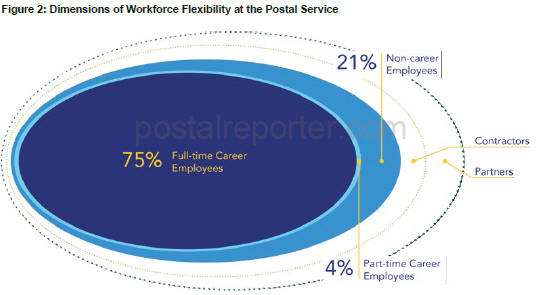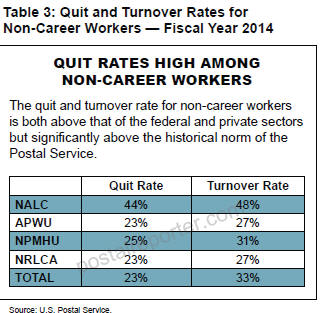USPS OIG white paper: Flexibility at Work: Human Resource Strategies to Help the Postal Service
Organizations in the United States and abroad are embracing flexibility policies that improve work-life balance for employees. Could flexible workplace policies help the U.S. Postal Service adapt to its new environment? Our research suggests that it can.
The Postal Service has a strategic need to attract adaptable, committed workers to compete in the future.
The OIG conducted primary and secondary research to discover innovative human resources practices in successful organizations.
Policies that improve work-life balance can attract committed employees and improve retention. Positive outcomes include a less stressed workforce, better customer service, and increased productivity.
The Postal Service is focused on workforce flexibility, using lower paid employees to supplement its career workforce. It should also focus on workplace flexibility policies that improve work-life balance.
A strategic partnership between management and the workforce throughout the organization will be needed to move toward a more flexible work culture.
Experimentation, feedback from employees, and better workload information and management tools all increase the likelihood that flexibility policies will succeed.
Our research yielded four high-level suggestions for the Postal Service to consider:
Create a strategic partnership for flexibility between labor and management.
Employees, unions, and management associations often will not buy into change without a corresponding corporate focus on employee well-being. Effective partnering on flexibility policies can enhance the trust between labor and management. The cornerstone of this partnership would be the development of joint labor and management flexibility teams at all levels of the organization to identify common ground and solutions to issues that separate them.
Improve information on workload to reduce uncertainty.One key reason flexibility is needed is that field managers,postmasters, and supervisors have incomplete or inaccurate information on the workload to expect on any given day. There is great potential to reduce the costs and delays associated with unexpected workload. The Postal Service should pursue technological solutions such as better analytics to better anticipate its workforce needs.
Seek continuous feedback from employees.
The Postal Service should employ an independent third party or request the U.S. Postal Service Office of Inspector General (OIG) to conduct a transparent survey to establish the current level of satisfaction with flexibility among postal employees. Independent, on-going follow up surveys of employees should be conducted to better understand what flexibility policies employees want. The Postal Service can use the survey data to improve the implementation and effectiveness of current policies.
Implementing successful flexibility policies could strengthen employee morale, improve performance, and attract a talented workforce, helping the Postal Service survive and thrive in this rapidly changing climate. By reducing turnover, absenteeism, and workplace accidents, flexibility could also enhance the Postal Service’s efforts to meet its long-term strategic goals of decreasing costs and providing the most consistent service.
Some flexibility policies have the potential to shift the cost of surplus labor from low-volume to peak-volume periods to assure timeliness of customer service and mitigate the need for load levelling. If hard-working, engaged, adaptable employees take their talents elsewhere, the Postal Service may find itself with a workforce of the past in a very competitive present and future.
We have several suggestions for pilot tests drawn from case studies and literature reviews, including practices being tested by organizations around the world. Each of these suggestions could be piloted by the Postal Service among bargaining workers as well as in the supervisory and management ranks.
●● Move to annualized workhours, which allows workers to trade overtime at busy periods for time off in slow periods to match customer demand and reduce forced overtime. Annualized workhours can mitigate the impact of peak loads on Postal Service finances and on postal customers.
●● Develop a work or job sharing process where the responsible employees have the latitude to cover each other’s absences.
●● Allow shift trades or self-scheduling where workers are able to apply for preferred shifts as often as possible.
●● Adopt team flexibility where team members are cross-trained.
●● Use versatile, supplementary employees to provide back up when regular staff workers are sick or a shift is understaffed.



Cut routes, hire people, stop punishing hard workers with excessive work.
The one thing i do agree with is that a more diverse employee across the board would benefit us greatly. i have been a letter carrier for more than 31 years and a more flexible schedule is fine with me. Maybe our union would consider this if such a plan were offered .
Where are these non traditional workers supposed to come from? We, in a major city in the northeast cannot retain workers at the currently offered wages. What has happened is a complete suspension of discipline, phony IOD’s for some paid time off and hiring in the words of HR “anyone that comes through the door.”
Couple this with non-career employees in supervisory positions and there are few people left that have any idea what’s going on. The rest of us count the days, 3 years, 10 months and 24 days for me, before we make the last punch. Will there be anything left?
It’s simple CUT ALL ROUTES……..!!!!!!!
All that you have to look at is 48% non career turnover rate to tell you why things are not going to change. Could that be management?
I made an extra 6000 dollars last year as an assignment only letter carrier. Why would I give that up? The routes are too long, especially with the increases in package volume. Most of the undertime downtown supposes is imaginary. the post office cannot be saved, it can only be bled dry.
Is it way overdue to get rid of the utterly useless OIG … THAT IS THE QUESTION.
Welcome to Dreamworld. While this stuff sounds all nicey-nicey and cooperative, the OIG omits one crucial factor: far too many in management are obstinate, stupid, labor hating jerks who would implement changes that helped with relations between labor and management over their dead bodies.
You can’t win a battle against a body of management that got where it is by being for the most part, and there are exceptions – I want to give credit to the good managers out there where it’s due – but as the old cliche says, one bad apple can ruin the whole basket. One terrible POOM can ruin their turf for everybody, district can ruin the whole state or district, and bad Area inflicts harm on several states or large segments of the population. And we all know what L’Infant Plaza is – corrupt, arrogant and criminal to its rotten core.
And does the OIG really think workers who work overtime will pass up the overtime wages for promises of administrative leave for a day to be announced? That would mean whatever time they took on a slow day would be straight time, and management would probably demand they use annual leave, not admin.
We didn’t all fall off the turnip truck yesterday, contrary to popular management belief. Thus, the white paper is worthless. Quit wasting your time. Go after corrupt management policies instead.
Compressed work week of 4 x 10 hour days proposed years ago. nationals balked at the proposal…
In the 60s as a PTF you could be scheduled no less than 6 hours with an unlimited break. Clerks could be scheduled 8AM to 10AM and back from 8-10 PM. Get the box mail up and back for dispatch and you whine?????
It’s take decades for the USPS to change for the better.
If only the Postal Service had leadership , and Congress would get out of the way.
can you imagine getting paid to think this crap up?!?
The only people that USPS mgmt. hates more than it’s customers, are it’s employees.
They will never adapt any of these ideas.